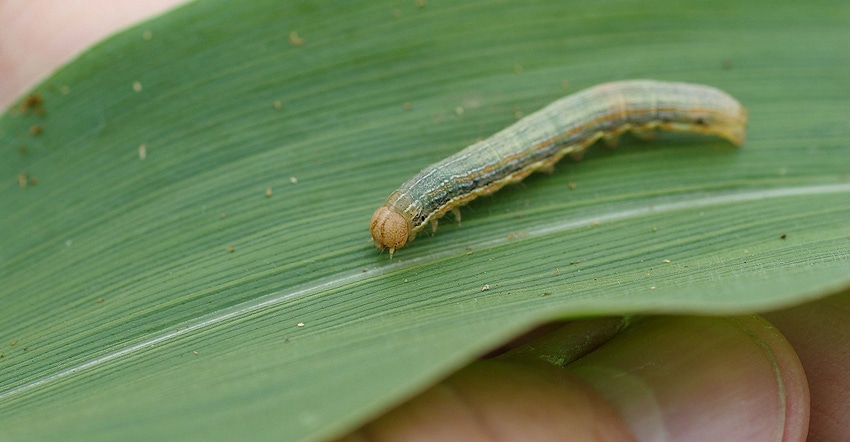
Armyworms are active right now, so it might be a good idea to start scouting your corn and hay for damage.
“I encourage growers to scout their corn, wheat and hayfields for armyworm damage,” according to John Tooker, Penn State Extension entomologist, in a recent Field Crops Update. “For corn growers, armyworm is more common following grass cover crops, but they can show up in other situations, including in alfalfa.”
Damage to corn begins from the edge of the leaves and will often look ragged with large pieces of tissues removed, he says, but armyworms rarely eat or cross the midrib.
“Armyworm can reduce yield. If left unchecked they can defoliate entire plants. I cannot give you a number, but defoliated plants are not going to be very productive,” he says.
Del Voight, Extension agronomist in Lebanon County, Pa., says that he’s seen fields with up to 10% damage thus far, but the armyworms he saw in fields he scouted last week were only a half-inch in length, meaning damage could get much worse once the critters grow larger.
When to look for damage
Tooker says that most damage happens overnight. In wheat, the armyworm will feed on leaves and then go up the head, which they can clip off for food. During the day they will hide at the base of the plants. He says to look for clipped heads on the ground as a sure sign of damage.
In corn, damage is mostly seen in no-till corn that was sod the previous year or had a small grain cover crop that wasn’t burned down early enough in the spring, according to Penn State Extension. You can also see damage in late July or August with the second generation of armyworms, but this is rare.
Look for ragged feeding on the top leaves with wet, brown pellets. Armyworms can often be seen hiding under clumps of grass on the ground.
Time to scout
Only Bt corn hybrds that express the Vip3A protein will provide protection against armyworm, Tooker says.
Insecticidal seed coatings won’t provide good control, so scouting is the best way to get an idea of a problem and to get ahead of it.
“When scouting cornfields, look for leaf feeding and presence of caterpillars in the whorl. Control efforts are usually not economical unless 10% or more of the plants are infested,” Tooker says. “A variety of insecticides, including common pyrethroids, are available and effective for controlling true armyworm, but keep in mind that control gets to be more challenging as caterpillars grow and get to be one-inch long or greater.”
Preserving beneficials
A few products provide good control of armyworm and have little activity against predators and parasitoids. Tooker says that these include methoxyfenozide (Intrepid 2F, Troubadour 2F) and spinosad (Tracer and Entrust, which is organically approved).
If infestation is heavy and the caterpillars are larger, use a higher rate.
For details on insecticide options, see the Penn State Agronomy Guide and consult labels for specifics for each product.
Tooker says that armyworms usually don’t target soybeans.
“Armyworms are grass feeders and do not develop well on soybeans,” he says. “Apparently, they can eat it a little, but will die slowly because it is nutritionally inadequate.”
About the Author(s)
You May Also Like






